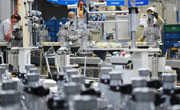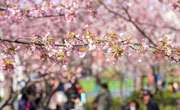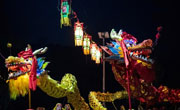Lima(Peru)
Lima(Peru)
[Overview] Lima is the capital city of the Republic of Peru. Located on the east coast of the Pacific Ocean at an altitude of 154 meters, the city covers an area of 2,672 square kilometers and has a population of 9.48 million.
[Politics] Located in the Department of Lima, the Lima Province is the country's only province that is directly administered by the central government, with the City of Lima being its capital city. The Mayor of Lima is also the Governor of Lima Province, and the city and the province share the same leadership. The City of Lima has an administrative committee, a mayor's office (the city government) and a city council, and the mayor also serves as chairman of the administrative committee and the city council. Consisting of 39 members who are elected by the constituents for a term of four years, the administrative committee is responsible for passing the policies, laws and resolutions formulated by the city government. The city council, which has 100 members including 42 district chiefs and 58 representatives from social organizations in Lima, is responsible for policy implementation and provides policy recommendations. The city government has a mayor, a deputy mayor and a secretary general of the administrative committee, and under it are various committees and organs responsible for work in specific areas. The incumbent mayor Jorge Muñoz Wells came into office in January 2019 for a term of four years.
[Economy] Lima is the political, economic, cultural, industrial and financial center of Peru, with its GDP accounting for over half of the national total. There are thousands of factories of various sizes in the city that are engaged in such businesses as textile, foodstuff, leather making, hat making, electric domestic appliances, cosmetics, tobacco processing, cement and rubber, generating output value that takes up two thirds of that of the national manufacturing industry. The city's main industries include manufacturing, service and tourism. The Port of Callao 12 kilometers away from the City of Lima is the largest port in the country, handling 80 percent of the country's imports and exports.
[Culture and Education] Lima is home to 3,500 primary and middle schools and 12 universities. The National University of San Marcos is one of the oldest universities in South America. The Historic Center of Lima is listed as a world cultural heritage site by UNESCO. The city is also home to the Gold Museum and the National Museum of Archaeology, Anthropology and History.
[Transportation] Lima is a transportation hub of Peru from which roads reach out to all corners of the country, and the Lima Jorge Chavez International Airport built in 1985 is an important airport in South America. The South American section of the Pan-American Highway runs through the east part of Lima, and its old city area houses the Central Railway Station of Peru, from which the railway runs eastward over the Andes all the way to La Oroya, a vital metallurgical base. There are also railways connecting Lima with the Port of Callao, Oroya and Cerro de Pasco.
[Relations with Beijing] Beijing and Lima officially became sister cities on November 21, 1983. Since then, the two cities have had extensive communication and cooperation in such areas as culture and education.
Culture: In 1999, the inauguration ceremony of the monument marking the 150th anniversary of the arrival of Chinese in Peru was held in the Chaoyang Park, Beijing. In 2001, the Beijing Cultural Week was held in Lima. In 2008, to celebrate the 25 years of sisterhood between the two cities, Beijing, with the help of the Chinese Embassy in Peru and the Lima city government, organized the Cultural Week event in Peru and staged a series of performances. In 2011, Beijing held the Charming Beijing photo exhibition in Lima in celebration of the 40th anniversary of the establishment of diplomatic ties between China and Peru. In 2016, Beijing held a guqin concert with the theme of “Lofty Mountains and Flowing Water” in Lima.
Education: In 1986, the Gu Cheng No.2 Primary School in Shijingshan District of Beijing was named the “China-Peru Friendship Primary School” to celebrate the 15th anniversary of the establishment of diplomatic ties between China and Peru and the 3rd anniversary of the formation of the sister-city relationship between Beijing and Lima.
利马市(秘鲁)
【概况】利马是秘鲁共和国的首都,地处太平洋东岸,海拔154米,面积2672平方公里,人口948万。
【政治】利马省位于利马大区,是全国唯一中央直辖省。利马市为利马省首府,利马市市长与利马省省长为同一人,利马市与利马省领导机构为同一套领导班子。利马市领导机构由市政委员会、市长办公室(市政府)和市议事机构构成。市长兼任市政委员会和市议事机构主席。市政委员会共有39名市政委员,委员由市民普选产生,任期4年。市政委员会负责通过市政府制定的政策、法律和决议。市议事机构包括42名区长和58名利马市社会组织代表(共100人),负责协调有关政策的执行并对政策提出建议。利马市政府设市长1人,副市长1人,市政委员会秘书长1人。市政府下设各委员会及相关机构,负责分管城市各领域工作。现任市长乔治·穆诺兹·威尔斯于2019年1月就职,任期4年。
【经济】利马是秘鲁全国政治、经济、文化中心,主要工业及金融中心,地区生产总值占全国一半以上。拥有纺织、食品、制革、制帽、家用电器、化妆品、烟草加工、水泥、橡胶等大小工厂几千个,产值占全国制造业的2/3。该市主要产业为生产制造业、服务业和旅游业。距利马城12公里的卡亚俄港,是秘鲁最大的港口,全国约有80%的进出口货物在此装卸。
【文化教育】利马有3500所中小学,12所大学。国立圣马科斯大学,是南美最古老的高等学府之一。利马老城区被联合国科教文组织列入世界文化遗产。著名博物馆有黄金博物馆、国立人类学博物馆。
【交通】利马的豪尔赫·查韦斯国际机场建于1985年,是南美洲重要的航空港。利马是秘鲁的交通中心,公路从利马向全国辐射延伸。南美洲国际泛美公路从利马城东穿过。利马旧城有秘鲁中央铁路总站,铁路向东穿行,越过安第斯山,可到达重要的冶金基地-拉奥罗亚城。利马还有铁路通往卡亚俄港、奥罗亚、塞罗-德帕斯科等地。
【两市交往】1983年11月21日,北京市与利马市正式建立友好城市关系。结好以来,两市在文化、教育等领域开展了广泛的交流与合作。
文化领域:1999年,纪念华人抵达秘鲁150周年纪念碑落成揭幕仪式在朝阳公园举办。2001年,我市在利马举办“北京文化周”。2008年,为庆祝“北京-利马结好25周年”,我市赴秘鲁举办演出,中国驻秘鲁使馆与利马市政府配合组织了文化周活动。2011年,为庆祝中秘两国建交40周年,我市在利马市举办了“魅力北京”图片展。2016年,我市在利马市举办“高山流水”古琴音乐会。
教育领域:1986年,为纪念中秘建交15周年以及北京市与利马市建立友好城市关系3周年,石景山区古城第二小学被命名为“中秘友谊小学”。
(Source: Foreign Affairs Office of Beijing Municipal Government)
[ Editor: WPY ]










More From Guangming Online
Medics from Fujian leave for Shanghai to aid in battle against COVID-19 resurgence
New int'l land-sea transport service to Indo-China Peninsula launched
Another makeshift hospital under construction in Shanghai
Tourists view tulips in Suiping County, Henan
In pics: blooming gagea flowers on grassland in Zhaosu, Xinjiang
Greek workers stage 24-hour general strike over high prices